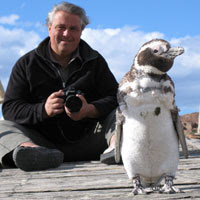
White Rhino at Solio Reserve close to Rhino Watch Kenya
( Copyright Birgit Stuwe )
16 June 2008 | News - Press Release
African rhinos have reached record numbers for the first time in decades, but the Northern white rhino (Ceratotherium simum cottoni) is on the brink of extinction.
The figures, complied by the IUCN Species Survival Commission African Rhino Specialist Group, show there are now more than 21,000 African rhinos.
According to the results, the white rhino (Ceratotherium simum) has increased from 14,540 in 2005 to 17,480 in 2007. It is listed as Near Threatened on the IUCN Red List of Threatened Species™, but one of its two subspecies, the Northern white rhino, is listed as Critically Endangered and is on the brink of extinction.
It is restricted in the wild to Garamba National Park in the Democratic Republic of Congo and the only remaining population was reduced by poaching from 30 in April 2003 to only four confirmed animals by August 2006.
“Worryingly, recent fieldwork has so far failed to find any presence of these four remaining rhinos,” says Dr Martin Brooks, Chair of the IUCN SSC African Rhino Specialist Group. “Unless animals are found during the intensive surveys that are planned under the direction of the African Parks Foundation, the subspecies may be doomed to extinction.”
In contrast, the other subspecies, the Southern white rhino (Ceratotherium simum simum), is listed as Near Threatened on the IUCN Red List and continues to increase in numbers and range.
Similarly, the population of African black rhino (Diceros bicornis), has increased from 3,730 in 2005 to 4,180 in 2007, although it still remains Critically Endangered on the IUCN Red List. In the last two years alone, numbers have risen by about 450 animals, with several new populations being founded or enhanced through translocation, such as in North Luangwa National Park, Zambia.

New born white Rhino at Solio Reserve, close to Rhino Watch Kenya
( Copyright Birgit Stuwe )
“This is fantastic news for the African black rhino,” says Dr Richard Emslie, Scientific Officer of the IUCN SSC African Rhino Specialist Group. “However, these magnificent creatures are not out of the woods yet. They are still classed as Critically Endangered and face increasing threats of poaching and civil unrest. There is no room for complacency.”
The majority of African black rhino can be found in just four countries – Zimbabwe, South Africa, Namibia and Kenya but with increasing numbers in a number of other range states. All countries with breeding populations have recorded increases, except Zimbabwe, whose numbers are slightly down.
Poaching for rhino horn remains the rhino’s Achilles heel, and while under control in many countries it has been responsible for significant losses in both the Democratic Republic of Congo and Zimbabwe.
“Even though protection from poaching is critical, effective rhino conservation must also include intensive monitoring and biological management to ensure annual growth rates of at least 5 % per year so that surplus rhinos are made available to create new populations,” says Dr Martin Brooks.













